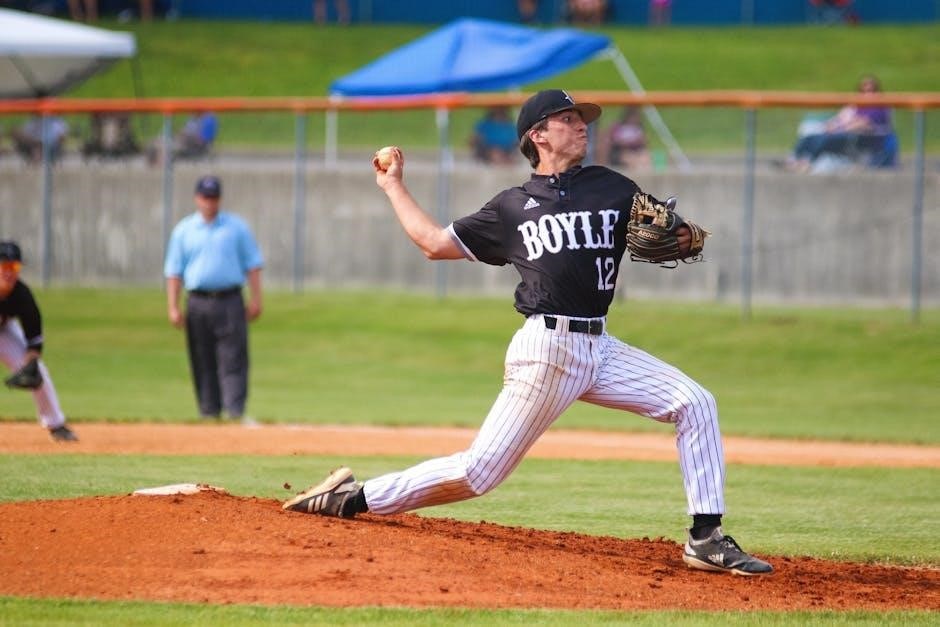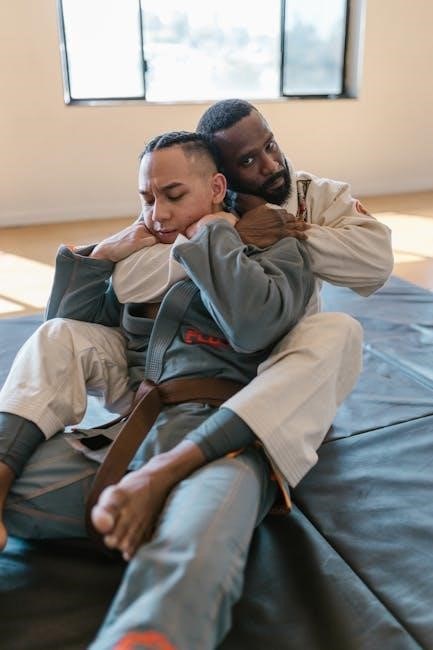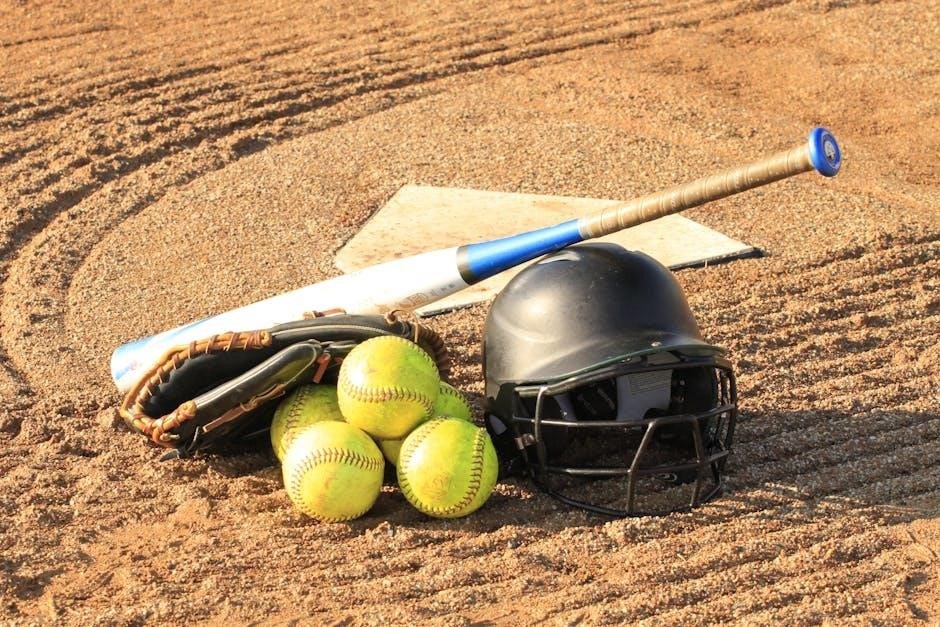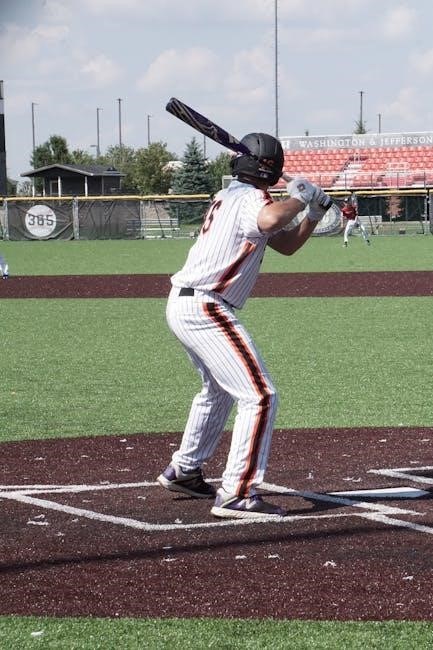Mastering baseball hitting requires consistent practice and a focus on fundamentals. This guide provides essential drills, strategies, and resources to help coaches and players improve their skills. Whether you’re a beginner or an experienced hitter, these drills will enhance your performance and confidence at the plate.
1.1 Importance of Hitting Drills in Baseball

Hitting drills are the cornerstone of baseball skill development, enabling players to refine their techniques and build consistency. These exercises focus on improving bat control, power, and the ability to perform under pressure. By practicing specific movements, hitters develop muscle memory, which is crucial for executing complex skills during games. Drills also enhance a player’s ability to analyze and adapt to different pitching strategies, fostering a deeper understanding of the game. Consistent practice helps players overcome common challenges, such as maintaining balance, tracking the ball, and generating efficient swing mechanics. Additionally, hitting drills promote mental toughness and confidence, allowing players to perform at their best in high-stakes situations. Whether focusing on fundamentals or advanced techniques, these exercises are essential for players of all skill levels to achieve long-term success in baseball.
1.2 Overview of the Guide
This comprehensive guide is designed to provide baseball players and coaches with a structured approach to improving hitting skills. It is organized into sections that cover the fundamentals of hitting, warm-up routines, and a variety of drills tailored to different skill levels. The guide begins with an introduction to the importance of hitting drills and an overview of the content. It then delves into the essential components of a successful swing, including grip, stance, eye on the ball, and basic swing mechanics. The guide also emphasizes the importance of balance and weight distribution, which are critical for generating power and maintaining control. Following the fundamentals, the guide outlines warm-up and stretching routines to prepare hitters for practice and games. These routines include both static and dynamic stretching exercises to enhance flexibility and mobility. The core of the guide consists of basic, intermediate, and advanced hitting drills, each designed to target specific aspects of a player’s technique. These drills are complemented by resources such as PDF downloads, including “The Baseball Drill Book” and “Hitting Drills List,” which provide additional practice plans and strategies. The guide also incorporates video analysis and mirror work to help players develop a greater awareness of their mechanics. By following this guide, players can systematically improve their hitting abilities, moving from foundational skills to more complex techniques. Coaches will find the guide particularly useful for structuring practices and tailoring drills to meet the needs of their team. The ultimate goal is to empower players with the tools and knowledge necessary to become their own coaches, enabling them to continue improving long after formal practices end. The guide’s emphasis on consistent instruction, video review, and specific drills ensures that players at all levels can achieve measurable progress and develop a deeper understanding of the game.

Hitting Fundamentals
Hitting fundamentals are the foundation of a successful swing. Key elements include a proper grip, balanced stance, tracking the ball, and efficient swing mechanics. These basics ensure consistency, power, and control, forming the building blocks for all hitting drills and techniques.
2.1 Grip and Stance
A proper grip and stance are the foundation of effective baseball hitting. The grip involves holding the bat with the middle knuckles of both hands aligned, creating a “V” shape with the hands. This ensures control and balance. The stance should be relaxed, with feet shoulder-width apart or slightly wider, knees slightly bent, and weight evenly distributed between both legs.
The hands should be positioned near the ears, with the bat angled upward. A slight weight shift toward the back leg (70/30 distribution) prepares the hitter for the pitch. This setup allows for optimal balance, enabling quick reactions and powerful swings. Coaches often emphasize the importance of consistency in grip and stance to build a repeatable swing mechanics.

Players should practice their grip and stance regularly, using drills like mirror work or video analysis to ensure proper form. A well-executed grip and stance lay the groundwork for improved bat control, better timing, and increased power at the plate.
2.2 Eye on the Ball and Tracking
Tracking the ball effectively is a critical skill for hitters, as it directly impacts timing and decision-making. Players must focus on the pitcher’s release point and follow the ball’s trajectory all the way to the bat. This ensures better pitch recognition and the ability to make precise swings.
Key elements of tracking include keeping the eyes focused on the ball, maintaining a relaxed and still head, and avoiding distractions. Drills like the “All-American Drill” and “Front Toss” are excellent for improving tracking. In these drills, hitters practice watching the ball closely without swinging, reinforcing their ability to follow its path accurately.
Coaches often emphasize the importance of staying calm and patient during tracking. Over-aggressive swings or premature movements can disrupt timing. By mastering this skill, hitters can better identify pitch types, locations, and speeds, leading to more consistent and effective at-bats.
Regular practice and video analysis can help players refine their tracking abilities. This foundational skill is essential for building confidence and improving overall hitting performance.
2.3 Basic Swing Mechanics
Mastering basic swing mechanics is foundational for any hitter. The swing begins with the hands positioned high, near the ear, and the bat angled slightly upward. As the pitcher releases the ball, the hitter initiates a small step forward with the front foot, transferring weight from the back leg to the front.
The load phase involves shifting approximately 70% of the body weight onto the back leg, with the bat knob pointing toward the catcher. This creates torque and prepares the body for the swing. The swing itself should be short, compact, and controlled, with the hands leading the bat head through the hitting zone.
Proper swing mechanics emphasize maintaining balance, generating power from the legs, and avoiding unnecessary movement. Coaches often use drills like tee work and soft toss to isolate and refine these mechanics. Players should focus on making consistent contact and avoiding uppercut swings, ensuring the bat stays level through the strike zone.

Regular practice and video analysis are crucial for identifying and correcting flaws in swing mechanics. By mastering these fundamentals, hitters can achieve more consistent and effective results at the plate.

2.4 Balance and Weight Distribution

Balanced weight distribution is critical for maintaining stability and generating power in a baseball swing. Hitters should start with their feet shoulder-width apart, knees slightly bent, and weight evenly distributed between both legs. This balanced stance allows for better reaction time and control during the swing.
As the swing progresses, weight shifts from the back leg to the front leg during the load phase. This transfer is essential for generating torque and power. The back knee should bend slightly, and the back heel should lift off the ground, indicating proper weight transfer. The front leg remains firm, acting as a stabilizing force.
Maintaining balance throughout the swing ensures consistent contact and prevents over-swinging. Coaches often emphasize drills that focus on balance, such as single-leg stands or swings with a narrow stance. These exercises help hitters develop the stability needed to maintain proper weight distribution.
Proper balance and weight distribution also enhance a hitter’s ability to adjust to different pitch locations and speeds. By staying balanced, hitters can maintain better plate coverage and make more consistent contact. Regular practice and video analysis are key to refining these mechanics.
Warm-Up and Stretching Routines
A proper warm-up and stretching routine is essential for hitters to prepare their muscles and improve flexibility. Static stretches target key areas like hamstrings and shoulders, while dynamic stretches mimic swing motions to enhance range of motion and power.
3.1 Static Stretching for Hitters
Static stretching is a crucial part of any hitter’s warm-up routine, helping to improve flexibility, reduce muscle tension, and prevent injuries. These stretches are performed by holding a specific position for 20-30 seconds, allowing the muscles to relax and lengthen. For hitters, key areas to focus on include the shoulders, neck, hamstrings, and lower back, as these are critical for generating power and maintaining proper swing mechanics.
- Shoulder Stretch: Hold a light weight or bat in front of your body and gently pull it apart, stretching your shoulders and chest.
- Neck Stretch: Slowly tilt your head to the side, bringing your ear toward your shoulder, and hold for 30 seconds on each side.
- Hamstring Stretch: Sit on the floor with your legs extended, reaching forward to touch your toes while keeping your knees slightly bent.
- Lower Back Stretch: Stand tall and interlock your fingers behind your back, gently squeezing your shoulder blades together to stretch your lower back.
Static stretching should be done after a dynamic warm-up to prepare the muscles for more intense activity. Consistency in these stretches will help hitters maintain range of motion and reduce the risk of strain during swings.

3.2 Dynamic Stretching to Prepare for Swings
Dynamic stretching is a vital warm-up component for hitters, designed to increase blood flow, improve mobility, and prepare the muscles for explosive movements. Unlike static stretching, dynamic stretches involve continuous motion, mimicking the actions of a baseball swing. These exercises help enhance flexibility, balance, and coordination, reducing the risk of injury and improving overall performance at the plate.
- Arm Circles: Hold your arms straight out to the sides and make small circles forward and backward. Gradually increase the size of the circles to loosen the shoulders and improve range of motion.
- Leg Swings: Stand tall and swing one leg forward and backward, then switch to the other leg. This helps activate the hips and lower body, essential for generating power in the swing.
- Torso Twists: Hold a bat or dowel across your shoulders and gently twist your torso from side to side. This drill improves rotational mobility and prepares the core for the twisting motion of the swing.
- High Knees: Run in place, lifting your knees as high as possible. This exercise increases heart rate and activates the legs, promoting quickness and agility.
Perform these dynamic stretches for 5-10 minutes before batting practice or games. Start with slow, controlled movements and gradually increase intensity to prepare your body for the demands of hitting. Consistency in this routine will enhance your swing mechanics and overall performance.
Basic Hitting Drills
Master the fundamentals with essential drills like tee work, soft toss, and front/backside stack drills. These exercises focus on consistency, bat control, and proper swing mechanics, building a strong foundation for hitters of all skill levels to improve their performance at the plate.
4.1 Tee Work for Consistency
Tee work is a foundational drill for developing a consistent swing. It allows hitters to focus on proper mechanics without the pressure of a moving pitch. Start by setting up a batting tee at a comfortable height, aligning it with the strike zone. Players should assume their natural stance and grip, ensuring hands are positioned correctly for optimal bat control.
Key focus areas during tee work include maintaining a level swing path, generating power from the legs, and making solid contact with the ball. Coaches often emphasize keeping the hands inside the ball and avoiding uppercut swings. Repetition is crucial, as it helps build muscle memory and consistency in the swing.
Players can also experiment with varying tee heights to simulate different pitch locations, such as high or low strikes. This variation helps improve bat control and the ability to hit to all fields. Regular tee work is essential for hitters of all skill levels, as it reinforces fundamentals and builds confidence at the plate.
4.2 Soft Toss Drills
Soft toss drills are an excellent way to improve bat control, timing, and the ability to hit consistent ground balls. This drill involves a coach or teammate tossing the ball underhand from a short distance, simulating pitch placement. The hitter focuses on making solid contact, aiming to hit the top half of the ball for ground balls.
Key elements of soft toss drills include maintaining a short, controlled swing and keeping the hands inside the ball. Players should practice hitting balls tossed to different locations, such as inside and outside pitches, to develop their ability to adjust and make precise contact. Coaches often emphasize the importance of staying balanced and using the legs to generate power.
Soft toss drills also provide an opportunity to work on situational hitting, such as moving runners over or hitting behind a runner. By varying the height and location of the toss, hitters can practice hitting to all fields and improve their overall plate coverage. This drill is particularly beneficial for infielders, as it also provides fielding practice for ground balls hit during the exercise.
4.3 Front Side Stack Drill
The Front Side Stack Drill is designed to help hitters improve their bat control and ability to make consistent contact. This drill focuses on the hitter’s front side mechanics, emphasizing proper weight distribution and balance. The hitter starts in their batting stance with their hands held high and close to their body, similar to the beginning of their swing.
A coach or teammate feeds the ball by tossing it underhand from a short distance, aiming for the strike zone. The hitter’s goal is to keep their hands inside the ball and make solid contact, focusing on hitting line drives or ground balls. The drill is particularly effective for teaching hitters to stay balanced and avoid over-swinging.
Coaches often incorporate variations, such as tossing the ball to different locations, to simulate various pitch placements. This helps hitters develop the ability to adjust their swing and hit to all fields. The Front Side Stack Drill is a valuable tool for improving bat control and ensuring hitters can handle different types of pitches effectively. By focusing on proper mechanics, this drill helps players build a consistent and powerful swing.
4.4 Backside Stack Drill
The Backside Stack Drill is a specialized hitting exercise designed to enhance a hitter’s ability to generate power and maintain proper swing mechanics, particularly focusing on the backside of the swing. This drill emphasizes the importance of weight transfer and hand positioning during the hitting process.
To perform the drill, the hitter starts in their batting stance with their hands held in a relaxed position near the center of their chest. The coach or teammate feeds the ball using a soft toss or tee, aiming for the strike zone. As the hitter begins their swing, they focus on “stacking” their hands and weight on their backside, creating a strong, balanced position.
The key to this drill is exaggerating the hand movement toward the catcher, ensuring the bat knob points directly at the pitcher. This helps develop a consistent swing path and improves the hitter’s ability to make solid contact. The Backside Stack Drill is particularly effective for teaching hitters to avoid common issues like lunging or pulling off the ball.
By focusing on proper weight distribution and hand placement, this drill helps hitters build a more powerful and controlled swing, leading to better performance at the plate. It is a valuable tool for players looking to refine their hitting mechanics and increase their overall effectiveness as a batter.

Intermediate Hitting Drills
Intermediate hitting drills focus on refining skills like bat control and power. High-low drills improve pitch recognition, while batting practice emphasizes ground ball hitting. Top hand and bottom hand exercises enhance grip strength and swing mechanics, preparing hitters for advanced techniques and game scenarios.
5.1 High-Low Drills for Bat Control
High-Low Drills are designed to improve a hitter’s ability to make consistent contact with pitches at varying heights. This drill focuses on bat control and the ability to adjust to different pitch locations. Coaches or partners can toss or hit balls at different heights, forcing the batter to adapt their swing path accordingly.
To set up, the batter stands in their usual stance while the coach or partner stands a short distance away. The coach alternates between high and low pitches, simulating game-like scenarios. The batter must focus on maintaining a short, controlled swing, ensuring solid contact with both high and low pitches.
Key points of emphasis include keeping the hands inside the ball, avoiding over-swinging, and maintaining balance throughout the swing. This drill helps hitters develop the ability to handle pitches in all zones, improving their overall bat control and plate discipline. Coaches can vary the difficulty by increasing the speed or unpredictability of the pitches, making it an excellent intermediate drill for refining hitting skills.
5.2 Batting Practice with a Focus on Ground Balls
Batting practice focused on ground balls is a highly effective drill for improving bat control and ensuring hitters can make consistent contact. This drill is particularly useful for teaching players to hit the top half of the baseball, which is ideal for generating ground balls.
To execute this drill, the coach or pitching machine should deliver pitches at a moderate speed, allowing the batter to focus on their swing mechanics. The batter should aim for a short, controlled swing, making contact with the ball at the optimal point to produce a ground ball. Emphasize keeping the hands inside the ball and avoiding an uppercut swing, which can result in fly balls instead of ground balls.
This drill not only helps hitters develop better bat control but also provides infielders with opportunities to practice fielding ground balls. Coaches can vary the difficulty by adjusting the pitch location or speed, challenging hitters to adapt while maintaining their focus on producing ground balls. Regular practice of this drill can lead to improved execution and confidence at the plate.
5.3 Top Hand and Bottom Hand Drills
Top hand and bottom hand drills are essential for developing a hitter’s strength, control, and bat manipulation. These drills isolate specific parts of the swing, allowing players to focus on proper mechanics and power generation. By separating the hands, hitters can better understand their role in the swing and improve overall performance.
The bottom hand drill involves removing the top hand from the bat, forcing the hitter to generate power and control using only the bottom hand. This drill is particularly effective for building strength in the wrists and forearms, which are critical for bat speed and authority. Conversely, the top hand drill isolates the top hand, emphasizing its role in guiding the bat and maintaining proper swing path.
Both drills can be performed using a tee, soft toss, or live pitching. Coaches often start with stationary balls (e.g., tee work) and gradually progress to moving pitches as the hitter becomes more comfortable. These drills not only enhance a player’s ability to make solid contact but also improve their ability to hit to all fields, making them a versatile and dangerous hitter.

Advanced Hitting Drills
Advanced hitting drills are designed to challenge experienced players, refining their skills and preparing them for high-level competition. These drills focus on complex swing mechanics, situational hitting, and mental preparation. One popular drill is the high-velocity batting practice, where hitters face pitches at game-like speeds to improve reaction time and decision-making.
Another advanced drill is the breakaway bat drill, which strengthens a hitter’s hands and wrists by using a weighted bat that “breaks away” upon contact. This drill enhances bat control and power. Additionally, situational hitting drills simulate game scenarios, such as hitting behind a runner or driving in runs with two strikes.
Advanced hitters also benefit from bunt variation drills, where they practice sacrificing, dragging, and pushing bunts to all fields. These drills improve versatility and strategic awareness. Coaches often incorporate video analysis and mirrors to provide immediate feedback, helping players refine their technique and develop a pre-swing routine for consistency.
These drills are tailored to push players beyond their comfort zones, fostering elite-level performance and mental toughness. By mastering advanced hitting drills, players can elevate their game and become impactful contributors to their team’s success.

